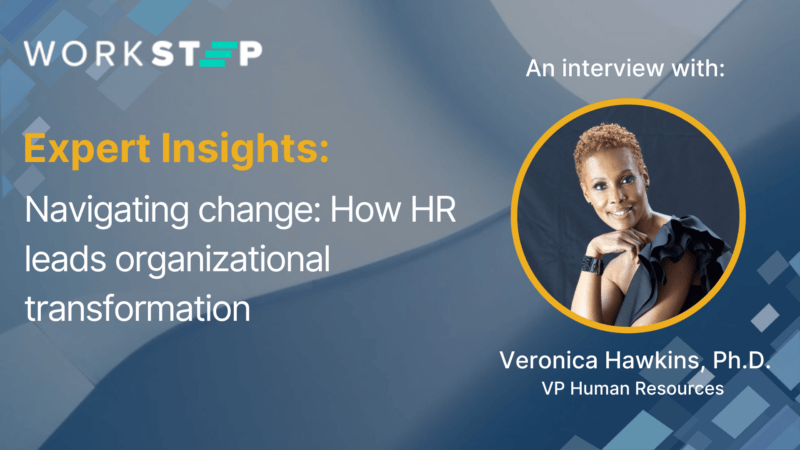Workforce Management Strategies
Navigating change: How HR leads organizational transformation
November 7, 2023
The WorkStep team recently had the pleasure of catching up with Veronica Hawkins, Ph.D., a valued thought leader in the Human Resources space with a successful history of developing and producing pipelines of talent and innovative problem-solving in retail manufacturing, healthcare, and logistics. Our conversation focused on the challenges and strategies related to change management within organizations, especially how seasoned HR leaders can drive strategic change by strengthening Operations partnerships.
Hawkins shared valuable insights about the importance of aligning HR initiatives with an organization’s overall strategy. She emphasized the significance of understanding the internal and external perceptions of HR, which play a pivotal role in gaining executive leadership buy-in for strategic projects.
A strong HR team is critical in driving change
When looking to implement new HR programs in an organization, Hawkins emphasized the importance of understanding the context, culture, experiences, and beliefs of the internal HR team. Hawkins shared some key learnings from her decades of experience, “Sometimes we go in attempting to build a new house on an unknown foundation. We’re going in as HR leaders and expecting that the way we ran our last HR team is the way that this team functions,” Hawkins said. “The challenge I’ve faced over the years with new HR programs is really thinking about who is going to be my co-captains, my team in implementing the HR program.”
From delivery models to competencies, the current state of the HR team provides a foundation upon which new programs can be built. Hawkins highlighted the need for continuous learning, encouraging team members to venture outside HR to gain broader organizational experience and the importance of building strong relationships with operations counterparts. She further emphasized the importance of staying relevant and keeping the team’s skills sharp, stating, “I expect you to go out and be a part of your community. I expect you to go out and keep honing your craft of HR.”
Hawkins emphasized the importance of remaining in what she calls “a learning posture,” a philosophy that keeps her open to new and sometimes opposing ideas while helping her remain a student of related disciplines, such as finance or operations, so that she can better understand what motivates those stakeholders. Hawkins takes those findings and brings new insights back to her team regularly – encouraging her team to do the same while pushing them to go a step further.
“I talk about my newly acquired certifications, podcasts that I’m participating in, or articles that I’ve read. Doing so helps to set the expectations from the top. So I tell my team, go to operations, go into finance, raise your hand for those assignments, and then come back a much more prepared leader,” Hawkins said. Her viewpoint and delivery highlight the importance of having a leader at the top who teaches by example, provides the space for their team to emulate positive habits, and delights in shared curiosity.
Hawkins pointed out that to implement change within an organization, HR leaders need to set a clear vision and invite team members to see themselves in that future. This helps keep employees engaged and motivated during organizational change initiatives.
She also urged HR leaders to be courageous. “Be an HR leader who’s not afraid to say, no, not now, might we consider or have you considered? So let’s not be the yes person. Let’s be the person that says, hey, let’s take a pause and see where we are and figure out how we can do this better, faster, simpler, easier,” she advised.
Coordinating cross-functional organizational alignment
“As a first step,” Hawkins began, “I would encourage any leader, particularly within HR, to ensure the HR scope of work is aligned to our organization’s strategy.” To be clear, for Hawkins, alignment means mirroring the language in the organization’s strategic documentation within her own initiatives, parroting key phrases from other executive stakeholders, and building upon that foundation with new ideas.
Hawkins recommended ensuring that the HR scope of work is aligned with the organization’s strategy. “When the pull for HR is greater than the push for HR, I feel like that’s when we’re winning,” she noted. The burden of being a great leader is that they should always work to win their seat at the table, every single day. Hawkins went on to say, “Making sure that we are strategically aligned, that we have the right talent in place to deliver the appropriate work, that we stay relevant, that we keep our skills sharp, and that we have great internal partnerships – those are the things that keep you at the table.”
Hawkins does not underestimate the value of cross-functional collaboration, especially early in a project’s lifecycle. By understanding her peers, their KPIs, and their motivations, she can build HR initiatives off of the things that are important to them. She invites them into the work, shows them that their perspective holds weight, and encourages them to think about the long-term vision. Hawkins recruits peers from cross-functional teams to join her initiatives because they provide key insights and earns her team buy-in from inception through implementation.
Why, you may ask? If a member of the Operations team joins in on a project in the early stages and helps shape its direction through completion, there should be a natural transparency all the way up to the COO. That means no surprises, and in that way, operations leaders have a hard time arguing with it because the team members they nominated were part of the process the whole way through.
Future-casting a Change Management Strategy
An effective change management strategy is essential, particularly when it comes to fostering collaboration between Human Resources (HR) and Operations teams. It serves as a structured approach to transitioning individuals, teams, and the organization itself from the current state to a desired future state.
Hawkins highlighted the importance of something she calls “future casting.” For her, this means setting a clear vision of where a project is going and allowing team members to see themselves operating in that future. If people understand where they fit into the equation, how they will get there, and what benefits will be unlocked, there will be significantly less resistance.
Here’s why it’s crucial, especially in the context of HR and Operations collaboration:
Minimizing resistance
Change can be met with resistance, and when HR and Operations don’t effectively manage this resistance, it can impede progress. Change management strategies help identify potential conflicts and proactively develop plans to address them. This could involve addressing concerns about new processes or policies, ensuring employees are adequately trained, and providing a clear rationale for the changes.
Improved collaboration
Collaboration between HR and Operations is vital for success. For example, HR may be implementing new talent management practices, and Operations must work closely with HR to ensure that these practices align with workforce needs and operational demands. Change management facilitates effective collaboration, leading to smoother implementation and better outcomes.
Enhancing employee experience
Change management focuses on ensuring that employees affected by changes are informed, engaged, and supported throughout the transition. When HR and Operations work together, they create a supportive environment for employees, helping maintain morale, productivity, and overall job satisfaction.
Optimizing resources
Efficiently managing change also involves optimizing human and financial resources. When HR and Operations collaborate effectively, they can allocate resources more strategically to support change initiatives. This includes investing in training, technology, or other resources that enable a successful transition.
Measuring and adapting
Change management incorporates metrics and feedback mechanisms to assess the progress and impact of changes. HR and Operations can use these insights to make necessary adjustments and improvements. This iterative process ensures that changes are not only implemented but also continuously refined for better outcomes.
Change management is a vital process in organizations. It plays a pivotal role in aligning HR initiatives with organizational goals, minimizing resistance to change, optimizing resource allocation, and improving the frontline employee experience. Effective change management ensures that HR and Operations work cohesively to transition the organization toward its desired future state, ultimately leading to better outcomes and a smoother, more successful transformation process.
Tom Goyette, Product Marketing Manager | tom.goyette@workstep.com
Tom Goyette is a Product Marketing Manager at WorkStep. With experience in start-up and enterprise level SaaS and eCommerce organizations, Tom excels at managing and creating content, marketing, and analytics. Tom believes people are at the center of every great organization and is eager to share stories that highlights the value of the employee voice.



